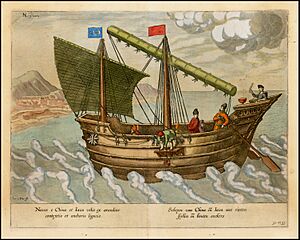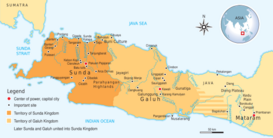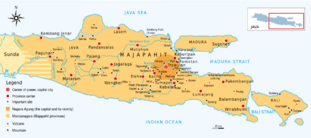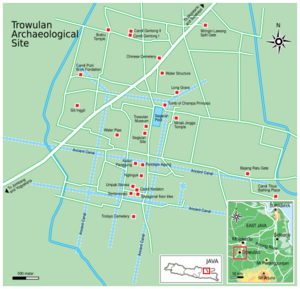Battle of Bubat facts for kids
Quick facts for kids Pasunda Bubat |
|||||||||
|---|---|---|---|---|---|---|---|---|---|
|
|||||||||
| Belligerents | |||||||||
| Sunda Kingdom | |||||||||
| Commanders and leaders | |||||||||
| Maharaja Lingga Buana † | |||||||||
| Strength | |||||||||
| Large number of Majapahit troops stationed in Majapahit capital, exact number unknown | The Sundanese royal family, the state officials, servants, guards, and mariners, exact number unknown At least 2,200 vessels (not all present during the battle) |
||||||||
| Casualties and losses | |||||||||
| Unknown | Almost all of Sunda party perished, including the Sunda King and Princess Pitaloka | ||||||||
The Battle of Bubat, also called Pasunda Bubat, was a tragic event in 1357. It was a clash between the royal family of the Sunda Kingdom and the powerful Majapahit army. This battle happened at Bubat Square, located in the northern part of Trowulan, which was the capital city of Majapahit in Java.
Contents
What Happened at Bubat?
"... manak deui Prěbu Maharaja. Lawasniya ratu tujuh tahun. Kena kabawa ku kalawisaya, kabancana ku seuweu dimanten, ngaran Tohaan. Mu(n)dut agung dipipanumbasna. Urang reya sa(ng)kan nu angkat ka Jawa, mumul nu lakian di Sunda pan prangprang di Majapahit, ..."
"... has a son, Prěbu Maharaja, being a king for seven years. Because of a disaster, got carried away by his daughter being a bride named Tohaan, requesting a heavy condition (wish). Many people started going to Java, because (she) did not want to get married in Sunda, thus there was a battle in Majapahit, ..."
The story of the Battle of Bubat is found in several old texts. These include Carita Parahyangan (from the 16th century) and Pararaton (from the 15th century). However, the Nagarakretagama (from the 14th century), which is a main source for Majapahit history, does not mention it.
The story of Bubat is the main topic of a Balinese manuscript called Kidung Sunda. This text was written around the mid-16th century. Some historians believe Kidung Sunda contains real historical facts. This is because the incident is also briefly mentioned in the older Sundanese text, Carita Parahyangan.
Historians have debated why the Nagarakretagama doesn't mention this event. Some think it was left out on purpose. This is because the battle didn't show Majapahit in a good light. It also showed a political failure for Gajah Mada, the prime minister.
A Royal Wedding Gone Wrong
"... Tumuli Pasunda Bubat. Bhre Prabhu ayun ing Putri ring Suṇḍa. Patih Maḍu ingutus anguṇḍangeng wong Suṇḍa, ahiděp wong Suṇḍa yan awawarangana ...,"
"... The start (cause) of Pasunda Bubat. Bhre Prabu who desires the Princess of Sunda sent Patih Madhu, a senior mantri (minister), to invite the Sundanese. Did not mind being a besan (in-law), came (Prabu Maharaja King of) Sunda (to Majapahit). "
"... Instead of being welcomed with a welcoming party, they face the harsh attitude of Mahapatih Gajah Mada who demands the Princess of Sunda as an offering. Sundanese parties disagree and are determined to war."
Hayam Wuruk, the King of Majapahit, wanted to marry Princess Citra Rashmi from the Sunda Kingdom. She was known for her great beauty. This marriage was likely for political reasons, to create an alliance.
A Majapahit official named Patih Madhu was sent to Sunda to propose the marriage. The King of Sunda was happy about the idea. He saw it as a chance to build a strong relationship with Majapahit, the most powerful kingdom in the area. So, the Sunda King agreed and decided to travel with his daughter to Majapahit for the wedding.
In 1357, the Sunda King and his royal family arrived in Majapahit. They had sailed across the Java Sea with a large fleet of ships. The royal family traveled on a grand, nine-decked ship. They landed at Hujung Galuh port, then sailed inland on the Brantas River. They finally reached the river port of Canggu.
The Sundanese royal party then set up camp at Bubat Square. This was in the northern part of Trowulan, the capital city of Majapahit. They waited there for the wedding ceremony to begin.
However, Gajah Mada, the powerful prime minister of Majapahit, saw things differently. He viewed the wedding as a chance to force Sunda to submit to Majapahit's rule. He insisted that Princess Pitaloka should not become a queen. Instead, she should be given as a sign of Sunda's surrender, like a concubine.
The Sunda King was very angry and felt insulted by Gajah Mada's demand. He decided to cancel the wedding and return home. But Majapahit refused to let them leave. They demanded the princess and surrounded the Sundanese camp.
The Tragic Outcome
According to the stories, Princess Dyah Pitaloka chose to take her own life. She did this to protect her family's honor and avoid being taken as a concubine. Her father, King Linggabuana Wisesa, and almost all the Sundanese royal party fought bravely against the Majapahit army. They were all killed in the battle.
King Hayam Wuruk was said to be very sad about Princess Pitaloka's death. The people of the Sunda Kingdom also mourned deeply. They had lost almost their entire royal family. Later, King Hayam Wuruk married his cousin, Paduka Sori.
In Sundanese tradition, Princess Pitaloka's act and her father's courage are seen as noble examples of honor and dignity. Her father, King Linggabuana Wisesa, is remembered as Prabu Wangi, meaning "king with a pleasant fragrance." This was because he bravely defended his honor against Majapahit. His future descendants were called King Siliwangi, meaning "successor of Wangi."
Gajah Mada faced criticism and distrust in the Majapahit court. His actions were seen as careless and brought shame to Majapahit. They also weakened King Hayam Wuruk's influence. This sad event marked the end of Gajah Mada's career. Soon after, the king forced him to retire early. Gajah Mada was given land far from the capital, in Madakaripura.
This tragedy severely damaged the relationship between the two kingdoms. It led to years of hostility, and things never returned to normal. Prince Niskalawastu Kancana, Princess Pitaloka's younger brother, was the only surviving heir. He had stayed in the Kawali palace in Sunda. After becoming king, he cut off diplomatic ties with Majapahit. He also made a law forbidding Sundanese people from marrying Javanese people. These actions showed the deep anger and disappointment of the Sundanese people. This event may still affect relations between Sundanese and Javanese people today.
Interestingly, even though Bali inherited much from Majapahit culture, Balinese stories like Kidung Sunda seem to side with the Sundanese. The Balinese admired the Sundanese for their courage. They saw it as a noble act, following the Hindu code of honor for kshatriyas (warriors). For a kshatriya, dying bravely in battle was considered the ultimate and perfect death.
Some sources suggest Sunda became a vassal state of Majapahit after this battle. However, it likely regained its independence later. If Sunda was indeed conquered, it would mean Gajah Mada had fulfilled his Palapa oath. This oath was his promise to unify the archipelago under Majapahit.
Lasting Impact
The Battle of Bubat is believed to have caused bad feelings between Sundanese and Javanese people for many generations. For example, in Bandung, the capital of West Java and a Sundanese cultural center, there were no streets named "Gajah Mada" or "Majapahit" until recently. Even though Gajah Mada is now considered an Indonesian national hero, many Sundanese people still don't see him as deserving of honor because of his actions at Bubat. Similarly, in Surabaya and Yogyakarta, there were no streets named "Siliwangi" or "Sunda."
This tragedy also led to a myth in Indonesia. It suggests that marriage between a Sundanese person and a Javanese person will bring unhappiness.
The battle has inspired many Indonesian stories and performances. These include wayang puppet shows and dance dramas. They often tell a tale of tragic romance, a battle between two kingdoms, and the death of a beautiful princess. Stories based on the Battle of Bubat are performed in wayang golek puppet shows, Sundanese sandiwara drama, and Javanese Ketoprak traditional drama. It has also inspired historical fiction books and even video games, like Age of Empires II HD: Rise of the Rajas.
Making Peace Today
The Battle of Bubat created a historical problem that caused tension between the Javanese and Sundanese people. These are two of the largest ethnic groups in Indonesia. Because of this, there have been efforts to improve their relationship. One way is by renaming city streets.
On March 6, 2018, the governors of East Java, West Java, and Yogyakarta met. They held a "Cultural Reconciliation of Cultural Harmony of Sunda-Java." They agreed to resolve the issues from the Bubat tragedy by renaming main roads in Surabaya, Yogyakarta, and Bandung.
In Surabaya, two main roads were renamed with Sundanese names. Gunungsari Road became Jalan Prabu Siliwangi, and Dinoyo Street became Sunda Road. Now, Jalan Prabu Siliwangi is next to Gajah Mada Street, and Sunda Road is next to Jalan Majapahit. The East Java Governor, Soekarwo, said, "Through this event, the problems between ethnic Javanese and Sundanese that occurred in the last 661 years are finished today."
In Bandung, Jalan Gasibu was planned to be renamed Jalan Majapahit. Jalan Kopo was to become Jalan Hayam Wuruk.
The Yogyakarta Governor, Sri Sultan Hamengkubuwono X, hoped these road namings would heal the past. He said Yogyakarta had already put Jalan Siliwangi, Pajajaran, and Majapahit together on one long road.
See also
- Kidung Sunda
- Pararaton
- Sunda Kingdom
- Puputan
- Territories of Majapahit






